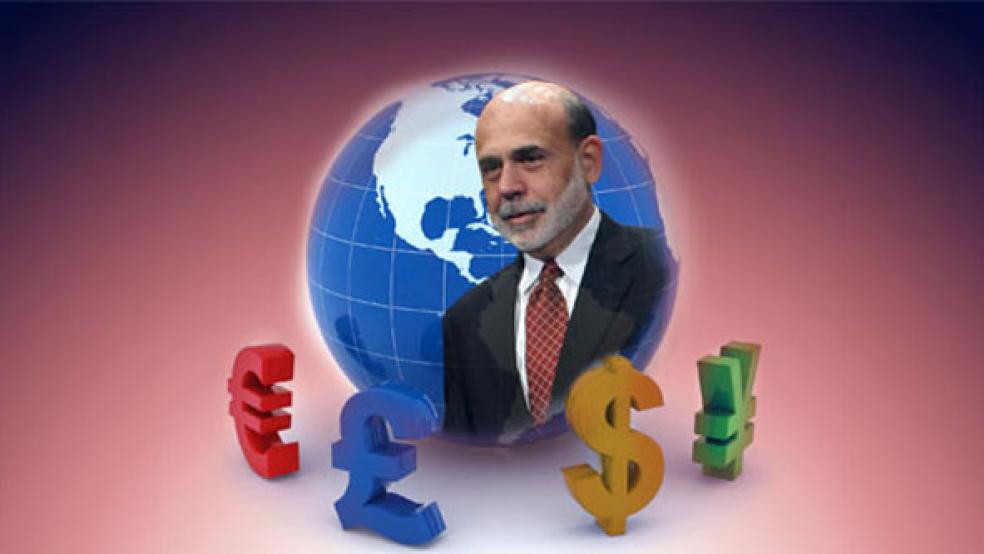Imagine Ben Bernanke as a grand puppet master. He has just written a new play called QE2. The plot is bold and controversial: The Fed buys trillions of dollars worth of Treasuries, pumping liquidity into a still fragile financial system in hopes of lowering long-term interest rates and the dollar, and boosting the stock market, exports, business and consumer confidence, and ultimately jobs. But as the curtain rises amid a cacophony of cheers and jeers, a strange thing happens. It appears that others are pulling the strings.
That’s essentially what played out on the world financial stage yesterday as global stock markets plunged for the seventh day in a row — and U.S. stocks for the fourth — on news of deepening Irish debt woes and South Korean interest rate hikes. The Dow Jones Industrial average dipped below 11,000 intraday for the first time since October 20 closing down 1.59 percent at 11,024. The broader S&P 500 dropped 1.62 percent with energy and natural resource companies hardest hit. Also falling were commodity prices, including oil and gold. Meanwhile, as investors sought safety, the dollar surged against the euro and modestly against other currencies. About the only good news for Bernanke: Treasuries prices rose pushing yields down.
Challenges from the Asia: Rising Interest Rates
In Asia, the South Koreans and Chinese were busy re-writing Bernanke’s reflation script to better suit their interests. Just days after President Obama left South Korea — with no U.S. export-boosting trade or currency deal — the Bank of Korea delivered another slap in the face to the U.S. interests, raising its base interest rate a quarter of a point to 2.5 percent, a move aimed at combating rising inflation. Also under consideration there: capital controls to prevent faster money flows into Korea.
Immediately, rumors swirled around global trading desks that the Chinese would be next to further tighten monetary policy and impose price controls, fueling fears of a global economic slowdown. Stocks on the Shanghai market plunged 4 percent yesterday and were trading lower this morning after news reports that Chinese Premier Wen Jiabao confirmed that China’s State Council is drafting price controls on commodities.
While the Fed can pump unlimited quantities of money into the system, it can’t control where that money flows. Much of it has been flowing — not into the U.S. stock market, or job-creating businesses — but into Treasury debt, commodities, developing markets like South Korea, and emerging markets like China and India. And no wonder: Money follows growth — and that’s where the growth is.
A strong dollar means our exports are less competitive, and our stock market more expensive to foreign investors. That's why stocks have been falling when the dollar rises.
The problem is that Bernanke’s money machine is fueling inflation and asset bubbles in Asian stocks and real estate. To combat that, South Korean and Chinese policymakers are beginning to tighten monetary policies and impose price and capital controls. But that means slower growth in Asia, which has been the engine of the global economy, pulling commodity-producing countries like Brazil and Australia along with it. Since the U.S. depends on those markets for its exports it’s never been more true that we’re all in this play together.
Challenges from Europe: A Stronger Dollar
Meanwhile in Europe, Bernanke’s plot is meeting other challenges. Yesterday, signs of a deepening debt crisis in Ireland — and worries that Spain could be next — sent investors rushing to buy up dollars, a typical safe haven in times of global financial stress. You might think a strong dollar is good for America, and it would be if it was a result of America’s economic strength. In this case, especially compared to the euro, the dollar is the best of a sorry lot. But a strong dollar means our exports are less competitive, and our stock market more expensive to foreign investors. That’s why stocks fall whenever the dollar rises.
So where does this leave us? Bernanke is doing his best to keep the U.S. economic recovery on track at a time when fiscal policy has been neutered by political gridlock. But in a global economy where money flows to places with the best returns, even a grand monetary poobah like Bernanke can’t pull all the strings. If we’re serious about restoring America’s economic and political stature in the world, we need to fix our long-term fiscal mess — and the competing proposals from the President’s bipartisan fiscal commission and the Bipartisan Policy Center offer a rare opportunity to do so. It’s time to seize it, and regain control over our national destiny.





